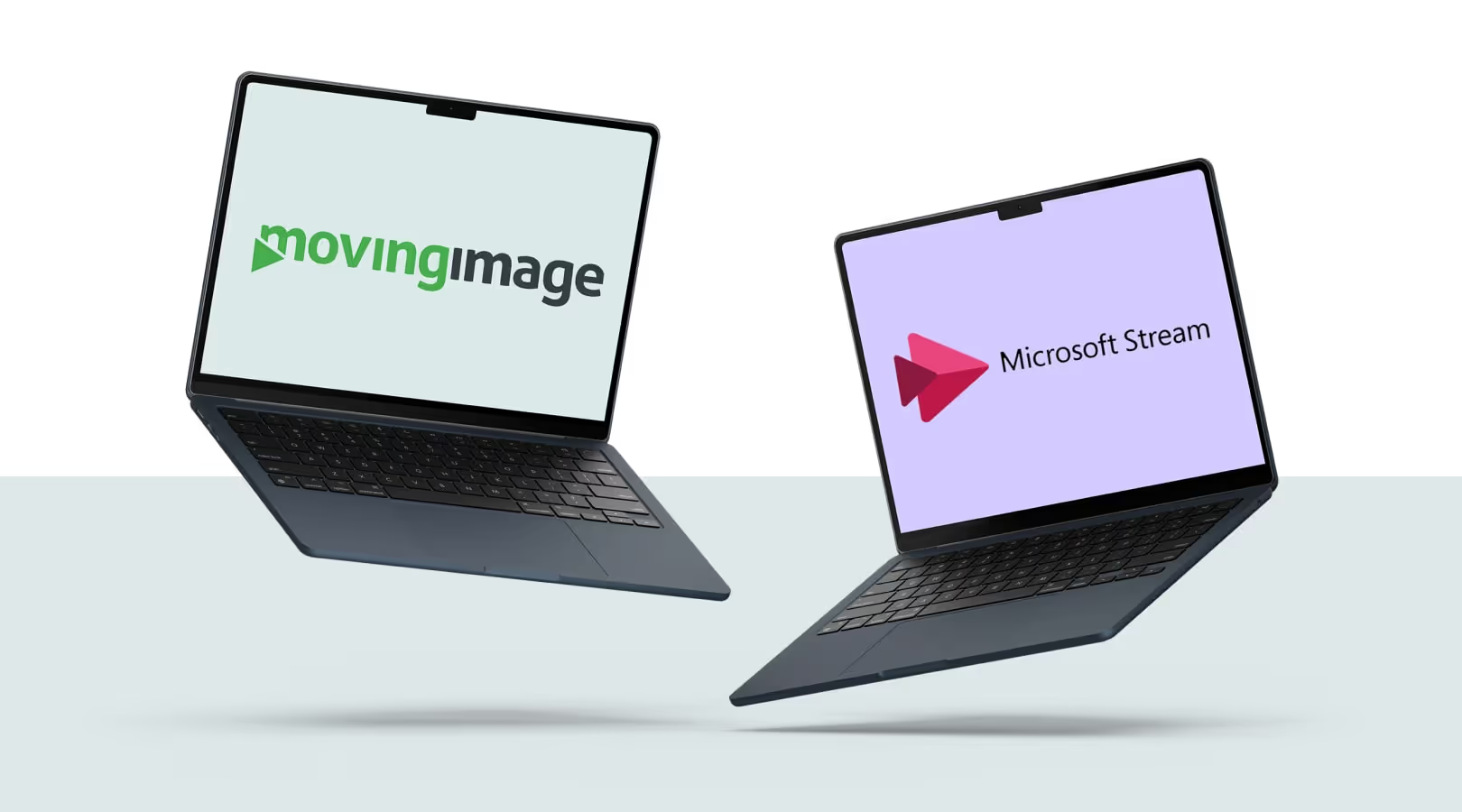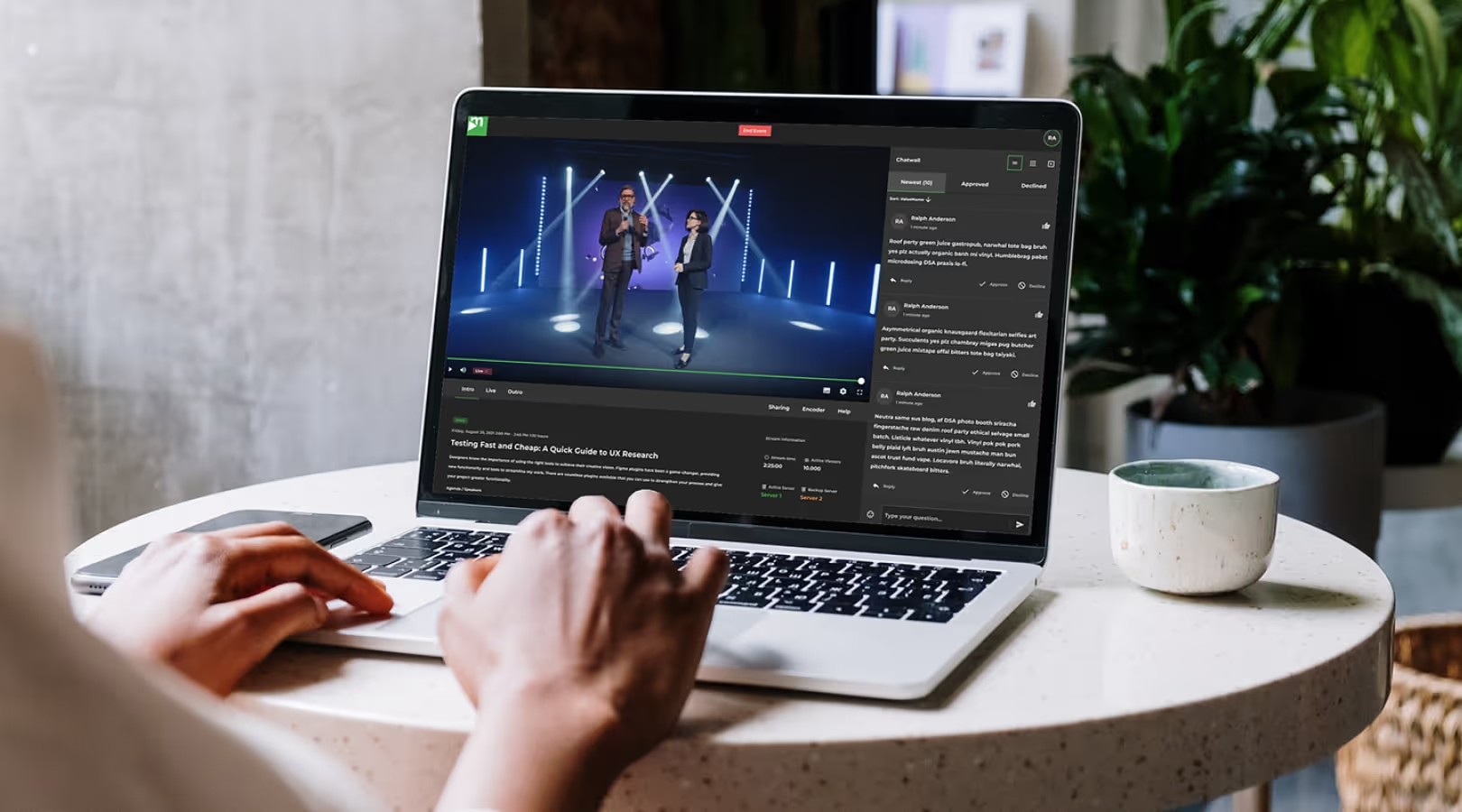Networking at virtual events

Driving your success with video

Networking at virtual events
Virtual events
These events take place without any physical interaction. Instead, participants navigate virtual spaces using personalized avatars. Content is often designed to be interactive and engaging.
Hybrid events
Hybrid formats combine physical and virtual event components. This blend of analog and digital creates a new event experience — one that’s seen as a driver of social innovation.
While there was some early skepticism about this shift, the advantages of digital formats are now becoming clear — thanks in large part to the possibilities opened up by digital transformation. As a result, many providers now offer networking features that integrate easily into existing event infrastructures, including streaming platforms and all-in-one solutions with built-in networking functionality.
Why networking matters
Networking is a key success factor in any career. In today’s job market, personal connections are often the biggest drivers when it comes to filling open roles.
But networking isn’t just helpful for job seekers — it also plays a critical role in building business relationships, sourcing suppliers, and working with external service providers.
Key benefits of networking at events:
- It enables meaningful peer-to-peer exchange and supports professional development.
- It positions you as an expert — especially valuable when job hunting.
- It fosters mutually supportive relationships and even acts as a talent marketplace.
- It builds confidence and lowers the barrier to making new contacts.
- It broadens your perspective — helping you see beyond your immediate role.
Traditional vs. virtual networking: key differences
In traditional networking, face-to-face contact is the trump card. That’s often seen as its biggest strength. Attendees naturally fall into conversation at in-person events — whether in the hallway, over lunch, or during a coffee break.
But these spontaneous conversations often rely on chance. It’s not always clear at first whether there’s a shared interest or professional overlap — much like a blind date.
Virtual networking doesn’t replace human connection entirely, but it does offer some unique advantages — especially when it comes to reach. At digital events, participants can connect with people they likely wouldn’t have met otherwise, dramatically expanding their professional network.
At virtual events, participants often connect with people they likely wouldn’t have met through traditional networking formats. That means the pool of potentially valuable contacts grows significantly in the digital space.
In particular, reserved or introverted individuals benefit from networking in virtual environments.
Compared to in-person events, virtual networking offers these participants a more approachable setting to build connections. In many cases, it represents a welcome and positive shift.
Reaching out to new people online removes a major hurdle — the initial face-to-face contact — which can be intimidating for some.
Instead, introverted attendees can get to know potential contacts in advance, browsing profiles and learning more about them before initiating a conversation.
This often happens via social media or event chats, making it easy to take that first step without pressure.
Virtual networking preserves a sense of distance and anonymity, which tends to suit more reserved personalities. In short, it allows for a more thoughtful, less rushed approach to making new connections.
How to promote networking at virtual events
Unlike in-person events, networking at virtual events doesn’t happen spontaneously. There’s no chance to casually bump into someone in the lobby, join a breakout session face-to-face, or grab a coffee together on the terrace of a conference venue.
That makes organizing and integrating networking opportunities into virtual events a real challenge.
It’s essential to actively engage your audience and create meaningful connections. That means building in deliberate networking opportunities — and doing so with creativity and flexibility.
Traditional tools like chat functions, messaging, or virtual meeting rooms during breaks form the foundation of virtual networking. But for truly effective results, it’s the creative and innovative ideas that make the biggest impact.
Smart networking features to implement
Use session chats
Live chat is a must — but session-specific chat takes things further. It doesn’t replace personal conversations but helps them get started. Participants can connect casually and easily, with emojis and likes adding extra engagement.
Offer real-time messaging
Real-time messaging allows attendees to reach out to one another directly. Moderators can use it to prompt interaction, or participants can start conversations when shared interests emerge, even if they’ve never connected before.
Host icebreaker sessions
To kick off meaningful networking, you first have to break the ice. Icebreaker sessions help participants and teams get to know each other — a key foundation for conversation later on. These can include gamified formats like quizzes or guessing games that are both fun and effective.
Set up virtual meeting rooms
Give attendees a place to connect outside of formal event sessions — whether it’s a virtual lounge, a lobby, or private rooms. These informal spaces let participants meet, chat, and network while waiting for the next session to begin.
Create social media groups
To extend the value of networking after the event, create private social media groups (on platforms like Facebook, LinkedIn, or X/Twitter). This way, the conversation can continue long after the final session ends.
Integrate gamification
Add playful elements to your event by assigning tasks or challenges that earn participants points. Just be sure the rewards are actually relevant and appealing — such as badges for attending company profiles or completing a number of video chats.
Include virtual cocktail hours
A virtual cocktail lounge or networking party can help participants relax and recharge while making new connections in a more casual setting.
Encourage speed networking
Schedule short, timed video calls that rotate participants automatically. It’s a fast and fun way to meet many new contacts in a short time.
Use networking carousels
With this format, conversation partners are assigned randomly — creating unexpected but often very rewarding combinations.
Organize team challenges
Activities like remote escape rooms, virtual wine tastings, or online mystery dinners are great ways to foster interaction and teamwork — even from a distance.
Use matchmaking tools
Leverage platforms that offer automated matchmaking. These tools pair attendees with shared interests or overlapping topics, helping the right people connect faster and more meaningfully.
Which networking platforms and tools stand out?
There’s no doubt that virtual networking is a key success factor for digital business events.
But to make it truly valuable and user-friendly, you need the right tools and platforms. Here are four providers offering particularly strong features for virtual networking:
movingimage
The movingimage virtual event platform is tailor-made for professional networking. With features like chat, 1:1 meetings, and automated matchmaking, it mirrors the feel of in-person events. Participants can create detailed profiles and connect in groups or private conversations. Plus, the platform delivers excellent streaming quality and strong engagement tools to keep interactions flowing throughout the event.
SpatialChat
This tool places participants into virtual rooms via live video bubbles. People can move freely, and the closer they get to one another, the clearer the sound becomes — just like in real life. It encourages spontaneous conversations and group discussions. Moderators can use the megaphone feature to speak to everyone at once, and the platform allows for customizable settings and backgrounds.
Remo
Remo is purpose-built for virtual networking. Participants can move between virtual spaces and tables, interact via integrated chat, take part in Q&A sessions, and use live reactions and screen sharing. With upvoting and video streaming features, it’s equally suited for keynotes and open discussions.
Trember
Trember lets you create personalized networking rooms on desktop or mobile. Each attendee is represented by a live video thumbnail and can navigate freely within the space. Background sounds are automatically softened for distant users. Rooms can be customized, used as whiteboards, or enhanced with pinned images and videos for shared experiences.
Final thoughts
Virtual networking may feel different than traditional formats, but it brings plenty of unique advantages.
With the right tools and a thoughtful setup, you can create dynamic opportunities for your attendees to connect — creatively, meaningfully, and at scale. A robust virtual event platform will help you bring your networking goals to life.
Our Speakers
Virtual events
These events take place without any physical interaction. Instead, participants navigate virtual spaces using personalized avatars. Content is often designed to be interactive and engaging.
Hybrid events
Hybrid formats combine physical and virtual event components. This blend of analog and digital creates a new event experience — one that’s seen as a driver of social innovation.
While there was some early skepticism about this shift, the advantages of digital formats are now becoming clear — thanks in large part to the possibilities opened up by digital transformation. As a result, many providers now offer networking features that integrate easily into existing event infrastructures, including streaming platforms and all-in-one solutions with built-in networking functionality.
Why networking matters
Networking is a key success factor in any career. In today’s job market, personal connections are often the biggest drivers when it comes to filling open roles.
But networking isn’t just helpful for job seekers — it also plays a critical role in building business relationships, sourcing suppliers, and working with external service providers.
Key benefits of networking at events:
- It enables meaningful peer-to-peer exchange and supports professional development.
- It positions you as an expert — especially valuable when job hunting.
- It fosters mutually supportive relationships and even acts as a talent marketplace.
- It builds confidence and lowers the barrier to making new contacts.
- It broadens your perspective — helping you see beyond your immediate role.
Traditional vs. virtual networking: key differences
In traditional networking, face-to-face contact is the trump card. That’s often seen as its biggest strength. Attendees naturally fall into conversation at in-person events — whether in the hallway, over lunch, or during a coffee break.
But these spontaneous conversations often rely on chance. It’s not always clear at first whether there’s a shared interest or professional overlap — much like a blind date.
Virtual networking doesn’t replace human connection entirely, but it does offer some unique advantages — especially when it comes to reach. At digital events, participants can connect with people they likely wouldn’t have met otherwise, dramatically expanding their professional network.
At virtual events, participants often connect with people they likely wouldn’t have met through traditional networking formats. That means the pool of potentially valuable contacts grows significantly in the digital space.
In particular, reserved or introverted individuals benefit from networking in virtual environments.
Compared to in-person events, virtual networking offers these participants a more approachable setting to build connections. In many cases, it represents a welcome and positive shift.
Reaching out to new people online removes a major hurdle — the initial face-to-face contact — which can be intimidating for some.
Instead, introverted attendees can get to know potential contacts in advance, browsing profiles and learning more about them before initiating a conversation.
This often happens via social media or event chats, making it easy to take that first step without pressure.
Virtual networking preserves a sense of distance and anonymity, which tends to suit more reserved personalities. In short, it allows for a more thoughtful, less rushed approach to making new connections.
How to promote networking at virtual events
Unlike in-person events, networking at virtual events doesn’t happen spontaneously. There’s no chance to casually bump into someone in the lobby, join a breakout session face-to-face, or grab a coffee together on the terrace of a conference venue.
That makes organizing and integrating networking opportunities into virtual events a real challenge.
It’s essential to actively engage your audience and create meaningful connections. That means building in deliberate networking opportunities — and doing so with creativity and flexibility.
Traditional tools like chat functions, messaging, or virtual meeting rooms during breaks form the foundation of virtual networking. But for truly effective results, it’s the creative and innovative ideas that make the biggest impact.
Smart networking features to implement
Use session chats
Live chat is a must — but session-specific chat takes things further. It doesn’t replace personal conversations but helps them get started. Participants can connect casually and easily, with emojis and likes adding extra engagement.
Offer real-time messaging
Real-time messaging allows attendees to reach out to one another directly. Moderators can use it to prompt interaction, or participants can start conversations when shared interests emerge, even if they’ve never connected before.
Host icebreaker sessions
To kick off meaningful networking, you first have to break the ice. Icebreaker sessions help participants and teams get to know each other — a key foundation for conversation later on. These can include gamified formats like quizzes or guessing games that are both fun and effective.
Set up virtual meeting rooms
Give attendees a place to connect outside of formal event sessions — whether it’s a virtual lounge, a lobby, or private rooms. These informal spaces let participants meet, chat, and network while waiting for the next session to begin.
Create social media groups
To extend the value of networking after the event, create private social media groups (on platforms like Facebook, LinkedIn, or X/Twitter). This way, the conversation can continue long after the final session ends.
Integrate gamification
Add playful elements to your event by assigning tasks or challenges that earn participants points. Just be sure the rewards are actually relevant and appealing — such as badges for attending company profiles or completing a number of video chats.
Include virtual cocktail hours
A virtual cocktail lounge or networking party can help participants relax and recharge while making new connections in a more casual setting.
Encourage speed networking
Schedule short, timed video calls that rotate participants automatically. It’s a fast and fun way to meet many new contacts in a short time.
Use networking carousels
With this format, conversation partners are assigned randomly — creating unexpected but often very rewarding combinations.
Organize team challenges
Activities like remote escape rooms, virtual wine tastings, or online mystery dinners are great ways to foster interaction and teamwork — even from a distance.
Use matchmaking tools
Leverage platforms that offer automated matchmaking. These tools pair attendees with shared interests or overlapping topics, helping the right people connect faster and more meaningfully.
Which networking platforms and tools stand out?
There’s no doubt that virtual networking is a key success factor for digital business events.
But to make it truly valuable and user-friendly, you need the right tools and platforms. Here are four providers offering particularly strong features for virtual networking:
movingimage
The movingimage virtual event platform is tailor-made for professional networking. With features like chat, 1:1 meetings, and automated matchmaking, it mirrors the feel of in-person events. Participants can create detailed profiles and connect in groups or private conversations. Plus, the platform delivers excellent streaming quality and strong engagement tools to keep interactions flowing throughout the event.
SpatialChat
This tool places participants into virtual rooms via live video bubbles. People can move freely, and the closer they get to one another, the clearer the sound becomes — just like in real life. It encourages spontaneous conversations and group discussions. Moderators can use the megaphone feature to speak to everyone at once, and the platform allows for customizable settings and backgrounds.
Remo
Remo is purpose-built for virtual networking. Participants can move between virtual spaces and tables, interact via integrated chat, take part in Q&A sessions, and use live reactions and screen sharing. With upvoting and video streaming features, it’s equally suited for keynotes and open discussions.
Trember
Trember lets you create personalized networking rooms on desktop or mobile. Each attendee is represented by a live video thumbnail and can navigate freely within the space. Background sounds are automatically softened for distant users. Rooms can be customized, used as whiteboards, or enhanced with pinned images and videos for shared experiences.
Final thoughts
Virtual networking may feel different than traditional formats, but it brings plenty of unique advantages.
With the right tools and a thoughtful setup, you can create dynamic opportunities for your attendees to connect — creatively, meaningfully, and at scale. A robust virtual event platform will help you bring your networking goals to life.



.avif)


.avif)






.avif)





